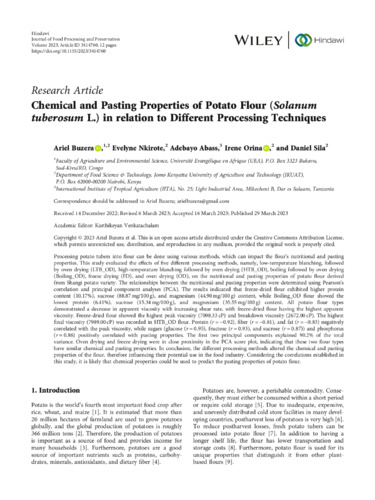Chemical and pasting properties of potato flour (Solanum tuberosum L.) in relation to different processing techniques
Abstract
Processing potato tubers into flour can be done using various methods, which can impact the flour’s nutritional and pasting
properties. This study evaluated the effects of five different processing methods, namely, low-temperature blanching, followed
by oven drying (LTB_OD), high-temperature blanching followed by oven drying (HTB_OD), boiling followed by oven drying
(Boiling_OD), freeze drying (FD), and oven drying (OD), on the nutritional and pasting properties of potato flour derived
from Shangi potato variety. The relationships between the nutritional and pasting properties were determined using Pearson’s
correlation and principal component analyses (PCA). The results indicated that freeze-dried flour exhibited higher protein
content (10.17%), sucrose (88.87 mg/100 g), and magnesium (44.90 mg/100 g) content, while Boiling_OD flour showed the
lowest protein (6.41%), sucrose (15.34 mg/100 g), and magnesium (35.55 mg/100 g) content. All potato flour types
demonstrated a decrease in apparent viscosity with increasing shear rate, with freeze-dried flour having the highest apparent
viscosity. Freeze-dried flour showed the highest peak viscosity (7098.33 cP) and breakdown viscosity (2672.00 cP). The highest
final viscosity (7989.00 cP) was recorded in HTB_OD flour. Protein (r = −0:92), fiber (r = −0:81), and fat (r = −0:83) negatively
correlated with the peak viscosity, while sugars (glucose (r = 0:95), fructose (r = 0:93), and sucrose (r = 0:87)) and phosphorus
(r = 0:86) positively correlated with pasting properties. The first two principal components explained 90.2% of the total
variance. Oven drying and freeze drying were in close proximity in the PCA score plot, indicating that these two flour types
have similar chemical and pasting properties. In conclusion, the different processing methods altered the chemical and pasting
properties of the flour, therefore influencing their potential use in the food industry. Considering the correlations established in
this study, it is likely that chemical properties could be used to predict the pasting properties of potato flour.

